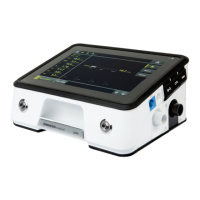
Do you have a question about the Lowenstein Medical LUISA LM150TD and is the answer not in the manual?
| Device Category | Respiratory Product |
|---|---|
| Application | Invasive and Non-Invasive Ventilation |
| Humidifier | Optional Heated Humidifier |
| Type | Transport Ventilator |
| Modes | CPAP |
| Inspiratory Time | 0.2 - 5.0 sec |
| FiO2 | 21 to 100 % |
| Battery Life | up to 8 hours |
| Alarms | High Pressure, Low Pressure, Apnea |
Specifies the device's purpose for life-support and non-life-support ventilation.
Explains the device's operation, blower, sensors, and user interface.
Defines user types (specialist vs. non-specialist) and required training.
Provides crucial safety precautions for handling the device and accessories.
Details precautions regarding EMC and potential interference.
Covers safe power supply methods and precautions.
Safety guidelines for handling oxygen supply with the device.
Explains symbols (WARNING, CAUTION, NOTICE) used for safety information.
Diagram and list of device components and ports.
Details the device's display interface and key functions.
Explanation of symbols used on the device display.
Lists optional accessories and their descriptions.
Describes the device's states: On, Standby, and Off.
Information on internal and external batteries, charging, and life.
Details the trolley accessory for device mobility.
Covers saving, transmitting therapy data, and firmware updates.
Steps for connecting the device to power and preparing it for use.
Instructions for connecting various circuit types to the device.
Configuration steps required before initial device operation.
Procedure for operating the device and starting/ending therapy.
Steps for conducting a circuit test to check for leaks and resistance.
Procedure for activating and calibrating the FiO2 cell.
Instructions for connecting the device to the LUISA mobile app.
Explains how to navigate through the device's menu system.
Overview of the structure and available menus within the patient interface.
Details parameters available in the Report menu for usage data.
Explains options within the System menu for tests and settings.
Details the parameters and functions within the Device settings menu.
Guidelines and procedures for cleaning the device and accessories.
Specifies the recommended frequency for cleaning different parts.
Instructions for cleaning the device housing and related parts.
Procedure for performing a function check after cleaning or repair.
Procedure for testing the functionality of various device alarms.
Information on device service life, battery replacement, and blower maintenance.
Instructions for the proper disposal of the device and batteries.
Explains the priority levels and display order of alarms.
Procedure for muting acoustic alarms and suspending muting.
Details how medical professionals can activate and configure physiological alarms.
Lists technical alarms, their causes, and recommended actions.
Information on connecting the device for remote alarm monitoring.
Illustrates pneumatic diagrams for different circuit types.
Details pneumatic resistance values for various circuits and components.
Specifies compliance levels for electromagnetic interference emissions.
Details compliance levels for electromagnetic interference immunity tests.
Explains symbols and markings applied to the device and accessories.
Lists the included parts in the standard scope of delivery.
Lists various optional accessories and their article numbers.
Identifies parts that can be removed for cleaning or replacement.
Details the warranty periods for the product and its components.
States the product's compliance with the Medical Device Directive 93/42/EEC.